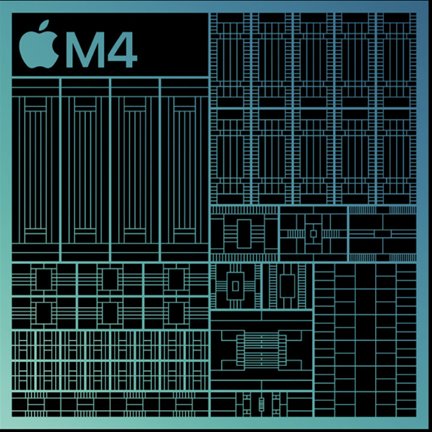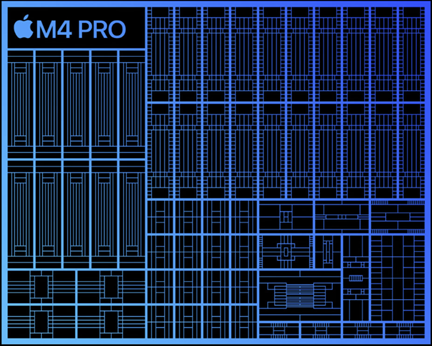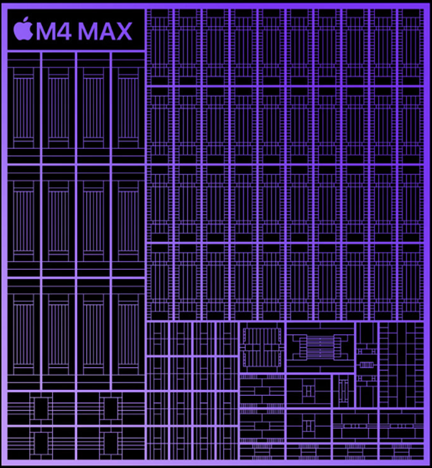Apple’s new M4, M4 Pro, and M4 Max chips improve Macs’ performance and efficiency, built with 3nm technology. The M4 family offers enhanced CPU and GPU capabilities, including faster cores, a twice-as-fast ray-tracing engine, and increased unified memory bandwidth. M4 Pro and M4 Max support Thunderbolt 5 and deliver data transfer rates of up to 120 Gbps. With up to 128GB memory in M4 Max, the chips are tailored for professional tasks, from complex video editing to AI workloads. Enhanced machine learning and graphics make them ideal for Apple Intelligence applications.

Apple has introduced its M4 Pro and M4 Max, two new chips joining the M4 to enhance Macs’ power-efficient performance and capabilities. All three SoCs are built with 3nm technology, which Apple says will improve performance and efficiency. The CPUs across the M4 lineup feature a high-performance CPU core, providing single-threaded and multi-threaded processing.
The GPUs are built on the graphics architecture from the previous generation with enhanced cores and a ray-tracing engine that Apple says is twice as fast as the last generation.
M4 Pro and M4 Max also support Thunderbolt 5 on Mac for the first time and, the company claims, boost unified memory bandwidth by up to 75%.
Additionally, says Apple, the Neural Engine offers twice the speed of the prior generation and enhanced machine learning accelerators in the CPUs, targeting high-performance processing for professional and AI-driven tasks.

These advancements contribute to processing for Apple Intelligence, Apple’s personal intelligence system, which the company says is designed for user productivity, communication, and creative expression, while prioritizing privacy.
The base M4 is a 10-core CPU with four performance cores, improved branch prediction, 10-wide instruction decode, and a larger reorder buffer. The next-generation ML accelerator’s six efficiency cores also improve branch prediction, double front-end fetch width, and have wider and lower-latency vector FP and next-generation ML accelerators.
The M4 supports up to 32GB of unified memory and has a higher memory bandwidth of 120 GB/sec. Apple says the M4 family’s display engine has been enhanced to support two external displays in addition to a built-in display. M4 now supports up to four Thunderbolt 4 ports, providing fast data transfer speeds and even more flexibility across peripherals.
The M4 Pro builds on the technologies introduced in the M4, scaling them up for users with demanding workflows, such as researchers, developers, engineers, and creative professionals. It features a CPU with up to 14 cores, comprising up to 10 performance and four efficiency cores. This configuration, says Apple, offers improved performance compared to its predecessors and competitors.
The GPU in the M4 Pro contains up to 20 cores, delivering enhanced graphics performance over the M4 and competing chips. This significant boost in performance accelerates tasks like building and testing apps across multiple simulators in Xcode.

The M4 family GPU includes an improved hardware-accelerated ray-tracing engine, which enhances the visual quality of games like Control and speeds up professional 3D rendering processes.
The M4 Pro supports up to 64GB of unified memory with 273 GB/sec of memory bandwidth, a 75% increase over the M3 Pro and, claims Apple, 2´ the bandwidth of any AI PC chip. This, combined with the faster Neural Engine of the M4 family, means on-device Apple Intelligence models run at blazing speed. M4 Pro also supports Thunderbolt 5 on Mac, delivering up to 120 Gbps data transfer speeds, which more than doubles the throughput of Thunderbolt 4. For professionals working on larger file sizes across AI, video, code bases, and more, M4 Pro offers stunning performance and Apple silicon’s legendary power efficiency.
Overall, the M4 Pro represents a substantial step forward in Apple’s chip technology, offering increased processing power and graphics capabilities to meet the needs of users with complex computational requirements.
The M4 Max is designed for professionals, data scientists, 3D artists, and composers. It features an up to 16-core CPU, comprising up to 12 performance and four efficiency cores.

The GPU in the M4 Max contains up to 40 cores, which Apple says delivers enhanced graphics performance compared to previous models and competing chips. This boost in processing power accelerates complex tasks like real-time denoising of raw video footage in DaVinci ResolveStudio.
M4 Max supports up to 128GB of unified memory with up to 546 GB/sec of memory bandwidth, which Apple says is 4´ the bandwidth of the latest AI PC chip. This allows developers to interact with large language models that have nearly 200 billion parameters. The enhanced Media Engine of M4 Max includes two video encode engines and two ProRes accelerators, making it a desirable choice for video professionals. And like the M4 Pro, the M4 Max also supports Thunderbolt 5 with up to 120 Gbps data transfer capability.
Apple Intelligence. Apple says its M4, M4 Pro, and M4 Max SoCs are designed to support Apple Intelligence, marking a new era for Mac computers. This technology, says Apple, combines generative models with privacy protections, leveraging Apple silicon and the Neural Engine to enhance user experiences.
Apple Intelligence will be available in US English with macOS Sequoia 15.1 and introduces systemwide Writing Tools for refining text through rewriting, proofreading, and summarizing. The redesigned Siri allows transitions between spoken and typed requests, helping with daily tasks and providing extensive product information.
Upcoming features will include Image Playground for creating original images and Genmoji for custom emoji generation. Siri’s capabilities will expand to perform systemwide actions and utilize personal context for tailored intelligence.
In December, ChatGPT integration with Siri and Writing Tools will offer users access to it within the Apple ecosystem. According to Apple, this integration aims to provide a more cohesive user experience by eliminating the need to switch between different applications or tools.
How to buy
Apple’s latest laptops, powered by the M4 chip series, are the first to support Thunderbolt 5 on their USB-C ports. The 14-inch model includes a third USB-C port. Additional features on both the 14-inch and 16-inch include an HDMI port supporting 8K resolution, an SD card slot, MagSafe 3 for charging, and a headphone jack. However, the new laptops do not support Wi-Fi 7, so they rely on Wi-Fi 6e and Bluetooth 5.3.
The starting configuration for the new MacBook Pro is priced at $1,599. It includes the base M4 chip with 16GB of RAM, 10 CPU cores, and 10 GPU cores. However, this version does not support Thunderbolt 5, but the M4 processor brings performance gains over the previous generation, with Apple reporting it to be 7´ faster for image processing, 10.9´ faster for 3D rendering, and 9.8´ faster for video editing compared to the 13-inch M3 MacBook Pro. Apple claims the M4 chip features the fastest CPU core available.
For users seeking higher performance, the M4 Pro model reportedly offers 3´ the speed of MacBook Pro models equipped with the M1 Pro. The entry-level M4 Pro model, priced at $1,999 for the 14-inch and $2,499 for the 16-inch, includes 24GB of RAM. At the top end, the 14-inch model with M4 Max costs $3,199, while the 16-inch version is priced at $3,499.
Both sizes of the new MacBook Pro include an improved Liquid Retina XDR display with an optional nano-texture coating ($150) for reduced glare, now reaching a peak brightness of 1,000 nits. They also come with a 12MP Center Stage camera, capable of following movement, showing the workspace, and delivering enhanced audio quality through a six-microphone array.
Pre-orders for the updated MacBook Pros are available in 28 countries, including the US, with shipments expected to start on November 8.